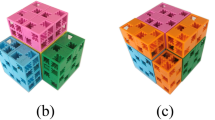Abstract
Although counting problems are easy to state and provide rich, accessible problem-solving situations, there is much evidence that students struggle with solving counting problems correctly. With combinatorics (and the study of counting problems) becoming increasingly prevalent in K–12 and undergraduate curricula, there is a need for researchers to identify potentially significant factors that might have an effect on student success as they solve counting problems. We tested one such factor among undergraduate students—their systematic listing of what they were trying to count. We argue that even creating partial lists of the set of outcomes led to significant improvements in performance in students’ success on problems, implying that systematic listing may be worthwhile for students to engage in as they learn to count. Our findings suggest that more needs to be done to refine instructional interventions that facilitate listing. We discuss these findings and suggest avenues for further research.
















Similar content being viewed by others
Notes
We do not use the term unproductive to suggest that listing is only beneficial if it yields a correct answer. We use the term as an efficient way to categorize listing that is or is not correlated with correct answers.
The students were assigned numbers based on the order in which their work is presented in the paper. Because gender information was not collected for each participant, we refer to students whose number is odd as female and whose number is even as male.
References
Abrahamson, D., Janusz, R. M., & Wilensky, U. (2006). There once was a 9-block…—a middle-school design for probability and statistics. Journal of Statistics Education, 14(1), 1–28.
Annin, S. A., & Lai, K. S. (2010). Common errors in counting problems. Mathematics Teacher, 103(6), 402–409.
Batanero, C., Godino, J., & Navarro-Pelayo, V. (2005). Combinatorial reasoning and its assessment. In I. Gal & J. B. Garfield (Eds.), The assessment challenge in statistics education (pp. 239–252). Amsterdam: IOS Press.
Batanero, C., Navarro-Pelayo, V., & Godino, J. (1997). Effect of the implicit combinatorial model on combinatorial reasoning in secondary school pupils. Educational Studies in Mathematics, 32, 181–199.
Carlson, M. P., & Bloom, I. (2005). The cyclic nature of problem solving: An emergent multidimensional problem-solving framework. Educational Studies in Mathematics, 58, 45–75.
Eizenberg, M. M., & Zaslavsky, O. (2004). Students’ verification strategies for combinatorial problems. Mathematical Thinking and Learning, 6(1), 15–36.
English, L. D. (1991). Young children’s combinatorics strategies. Educational Studies in Mathematics, 22, 451–47.
English, L. D. (2005). Combinatorics and the development of children’s combinatorial reasoning. In G. A. Jones (Ed.), Exploring probability in school: Challenges for teaching and learning (Vol. 40, pp. 121–141). New York: Springer.
Godino, J., Batanero, C., & Roa, R. (2005). An onto-semiotic analysis of combinatorial problems and the solving processes by university students. Educational Studies in Mathematics, 60, 3–36.
Hadar, N., & Hadass, R. (1981). The road to solve combinatorial problems is strewn with pitfalls. Educational Studies in Mathematics, 12, 435–443.
Halani, A. (2012). Students’ ways of thinking about enumerative combinatorics solution sets: The odometer category. In S. Brown, S. Larsen, K. Marrongelle, & M. Oshrtman (Eds.), Electronic Proceedings for the Fifteenth Special Interest Group of the MAA on Research on Undergraduate Mathematics Education (pp. 59–66). Portland, OR: Portland State University.
Harel, G. (2008). What is mathematics? A pedagogical answer to a philosophical question. In B. Gold & R. A. Simons (Eds.), Proof and other dilemmas: Mathematics and philosophy (pp. 265–290). Washington, DC: MAA.
Kapur, J. N. (1970). Combinatorial analysis and school mathematics. Educational Studies in Mathematics, 3(1), 111–127.
Kavousian, S. (2008) Enquiries into undergraduate students’ understanding of combinatorial structures (Unpublished doctoral dissertation). Simon Fraser University, Vancouver, British Columbia, Canada.
Lockwood, E. (2011). Student connections among counting problems: An exploration using actor-oriented transfer. Educational Studies in Mathematics, 78(3), 307–322. doi:10.1007/s10649-011-9320-7
Lockwood, E. (2013). A model of students’ combinatorial thinking. The Journal of Mathematical Behavior, 32, 251–265. doi:10.1016/j.jmathb.2013.02.008
Lockwood, E. (2014). A set-oriented perspective on solving counting problems. For the Learning of Mathematics, 34(2), 31–37.
Lockwood, E., Swinyard, C. A., & Caughman, J. S. (2015). Patterns, sets of outcomes, and combinatorial justification: Two students’ reinvention of counting formulas. International Journal of Research in Undergraduate Mathematics Education, 1(1), 27–62.
Maher, C. A., Powell, A. B., & Uptegrove, E. B. (Eds.). (2011). Combinatorics and reasoning: Representing, justifying, and building isomorphisms. New York: Springer.
Mamona-Downs, J., & Downs, M. (2004). Realization of techniques in problem solving: The construction of bijections for enumeration tasks. Educational Studies in Mathematics, 56, 235–253.
Martin, G. E. (2001). The art of enumerative combinatorics. New York: Springer.
Polya, G. (1945). How to solve it. Princeton, NJ: Princeton University Press.
Schoenfeld, A. H. (1992). Learning to think mathematically: Problem solving, metacognition and sense-making in mathematics. In D. A. Grouws (Ed.), Handbook for research on mathematics teaching and learning (pp. 334–370). New York: Macmillan.
Shaughnessy, J. M. (1977). Misconceptions of probability: An experiment with a small-group, activity-based, model building approach to introductory probability at the college level. Educational Studies in Mathematics, 8, 295–316.
Strauss, A., & Corbin, J. (1998). Basics of qualitative research: Techniques and procedures for developing grounded theory (2nd ed.). Thousand Oaks, CA: Sage.
Tillema, E. S. (2013). A power meaning of multiplication: Three eighth graders’ solutions of Cartesian product problems. The Journal of Mathematical Behavior, 32(3), 331–352. doi:10.1016/j.jmathb.2013.03.006
Tucker, A. (2002). Applied combinatorics (4th ed.). New York: Wiley.
Acknowledgments
The research described in this paper was funded by the Wisconsin Alumni Research Foundation. The authors wish to thank the foundation for its support. The authors would also like to thank Dr. Martha Alibali for her guidance in the project and for her contributions to the manuscript.
Author information
Authors and Affiliations
Corresponding author
Appendix 1
Appendix 1
Rights and permissions
About this article
Cite this article
Lockwood, E., Gibson, B.R. Combinatorial tasks and outcome listing: Examining productive listing among undergraduate students. Educ Stud Math 91, 247–270 (2016). https://doi.org/10.1007/s10649-015-9664-5
Published:
Issue Date:
DOI: https://doi.org/10.1007/s10649-015-9664-5




